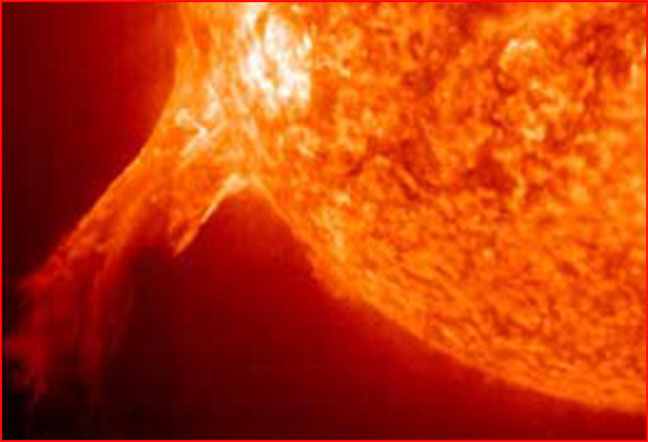
home •
about •
essential guide •
picture of the day •
thunderblogs •
news •
multimedia •
predictions •
products •
get involved •
contact
picture of the day archive subject index
Caption: A powerful coronal mass ejection. But the energy of this event cannot compare to a spectacular
stellar eruption recently observed in space.
Mar 22, 2007
A “Doomsday” Stellar Flare
Scientists using NASA's Swift Satellite have spotted a stellar flare on a nearby star so powerful that, had it been from our sun, it would have triggered a mass extinction on Earth.
A stellar explosion on a scale previously unimaginable for anything other than a supernova recently erupted on a modest star (slightly less massive than the sun) in a two-star system called II Pegasi in the constellation Pegasus. According to a NASA-Goddard news release, “It was about a hundred million times more energetic than the sun's typical solar flare, releasing energy equivalent to about 50 million trillion atomic bombs.” Were a comparable event to occur on the sun, it would result in a mass extinction due to the outpouring of lethal X-rays. The NASA report, however, adds a comforting observation: “Fortunately, our sun is now a stable star that doesn't produce such powerful flares.”
But this observation may seem a little less comforting when one realizes that, while astronomers speculate, they do not know what caused the event. Stellar instability, whether occurring as coronal mass ejections on our sun, the stellar flare of II Pegasi, or a supernova, pose numerous unresolved mysteries for astronomers simply because they ignore the electrical influences external to the star in question.
The II Pegasi flare, though vastly more energetic than any recorded coronal mass ejection on our sun, produced the same acceleration of the ejected charged particles as was first observed in solar eruptions. It is a compelling pointer to the existence of a powerful electric field in the chromosphere, just above the star's photosphere. Such fields, driven by galactic circuits, are easily able to accelerate particles up to a significant fraction of the speed of light. The most dramatic example of this occurred on January 20, 2005, when the charged particles of a massive solar eruption were accelerated along the spiral magnetic field between the Sun and Earth to velocities approaching one quarter the speed of light by the time they reached the Earth.
Particle acceleration is only half the story. Astronomers detected “hard” x-rays, which they euphemistically call “non-thermal” radiation. It is better known as synchrotron radiation, and it is only produced by electrons traveling at appreciable fractions of lightspeed in a strong magnetic field. It can be produced in laboratories—with electricity. Gravity or hot gas doesn’t come close.
In disregarding the laws of electricity, physicists can offer no plausible mechanisms of gravity or gas dynamics to explain such accelerations. They postulate “non-electrical” mechanisms for cosmic synchrotron radiation by extrapolating mechanical equations far beyond the domain in which those equations have been tested. They get away with this only because space probes can’t check on them.
High-energy flares on the sun arise from the breakdown of the current-regulating plasma sheath of the photosphere. The resulting "short circuit" causes the bright X-ray flash and acceleration of photospheric matter in the powerful electric field of the chromosphere. In the case of the II Pegasi explosion, the flash of X-rays was sufficient to overwhelm Swift’s X-Ray Telescope. In the quiet Sun, this same field of the photospheric sheath accelerates protons into the corona, where they collide with the coronal plasma and raise its temperature to millions of degrees.
The high energy of the II Pegasi flare is beyond the range of energies normally produced by gravity and gas mechanisms, but it is well within the range of electrical interactions. Astronomers are shocked only because they touched the “live wire” of cosmic plasma without donning the insulating gloves of electric plasma theory.
![]()
home •
thunderblogs •
forum •
picture of the day •
resources •
team •
updates •
contact us
EXECUTIVE EDITORS:
David Talbott, Wallace Thornhill
MANAGING EDITORS:
Steve Smith, Mel Acheson
CONTRIBUTING EDITORS: Michael Armstrong, Dwardu Cardona,
Ev Cochrane,
C.J. Ransom, Don Scott, Rens van der Sluijs, Ian Tresman
WEBMASTER: Brian Talbott
Copyright 2007: thunderbolts.info
